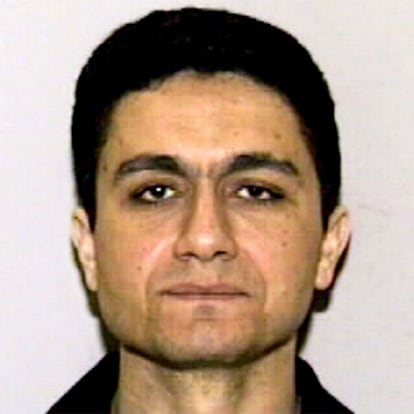The 9/11 meeting on Spanish soil
Suicide pilot Atta and a Yemeni saw to final details in town of Reus
The coordinators of the 9/11 terrorist attacks against the United States held last-minute preparations in Spain, according to classified documents made available by WikiLeaks. Ramzi bin al Shinbh, a prisoner in Guantánamo, met with Mohammed Atta, the leader of the suicide pilots, in the Catalan town of Reus in July 2001. This information is part of the extensive file that interrogators drew up on Bin al Shinbh, considered one of the most dangerous and valuable inmates at the US-run prison camp on the island of Cuba.
This file, which EL PAÍS has been given access to, shows that Bin al Shinbh, a Yemeni national, acknowledged the importance of this last meeting, and that he claimed not to have received any assistance from jihadists residing in Spanish territory at the time.
Both Atta and Bin al Shinbh left a trail at several hotels on the Spanish coast
The truck used in the Djerba attack was bought with money from Spain
The notes also detail his meetings with Osama bin Laden - whose death was announced by US President Barack Obama on Monday - and with Khalid Sheikh Mohammed, the real mastermind behind the attack that killed nearly 3,000 people.
Atta arrived in Madrid on a flight from Miami, spent one night at the Diana Cazadora hotel near Barajas airport, rented a car and traveled to the Catalan town of Salou, while Bin al Shinbh arrived in Reus on a flight from Hamburg. Both men left a trail at several hotels on the Spanish coast, where they booked rooms in their names, although it is still unknown where they slept for several nights.
Civil Guard investigations suggest that Mohammed Belfatmi, a Salafist who lived in the Reus area, lent them his home so they could hold discreet meetings there. Belfatmi's own trail grew larger when, following 9/11, it emerged that in August of that year he had taken the same flight as several of Bin al Shinbh's roommates in Hamburg who all traveled to Pakistan in order to drop off the radar before the so-called "holy attack" against the United States.
Atta and Bin al Shinbh also obtained false passports from an Algerian forger who lived down the Mediterranean coast in Murcia and whom they allegedly went to see, according to an analysis of the kilometer counter on their rental car.
While his Guantánamo file shows that Bin al Shinbh does not mention either Belfatmi (who remains at large) or the forger, he does admit that at the Reus meeting, Atta revealed the goals of the impending 9/11 attack and other relevant information. The Yemeni prisoner said that on September 5, 2011, just six days before the attacks that brought down the World Trade Center, he again flew from Hamburg to Madrid and stayed at a hotel on the downtown Carretas street, near Puerta del Sol. On the seventh, he took a flight out to Pakistan with a stopover in Dubai. While Bin al Shinbh was still in Madrid, the only member of the terrorist cell in Europe who knew what was going to happen telephoned Atta one last time to bid farewell to the Egyptian leader of the suicide pilots.
Bin al Shinbh never explained why he returned to Madrid on those dates, why he chose to fly to Pakistan out of the Spanish capital, or who helped him obtain a student card that got him discounts on his plane tickets. Investigators believe that Salafists living in Spain provided this support infrastructure, although they themselves did not know that they were aiding the biggest attack against the US since Pearl Harbor.
The file on Khalid Sheikh Mohammed, the 9/11 mastermind also being held in Guantánamo Bay, shows another Spanish connection with Al Qaeda leaders. The Pakistani admitted taking a call from the suicide bomber who drove into a synagogue in the Tunisian island of Djerba on April 11, 2002, killing 22 tourists (mostly French and German). The truck used in the attack was bought with money wired from Spain via a complicated transaction involving the owner of a call center in Logroño and a Valencian businessman who handled the accounts of a Pakistani friend without knowing that this old friend was a member of Al Qaeda. Enrique Cerdá, 48, was convicted of terrorist association and jailed.
Both Khalid Sheikh Mohammed and Bin al Shinbh were arrested in Pakistan in 2002 and taken to secret prisons until they reappeared at Guantánamo, where they were held in a special unit for valuable prisoners called Strawberry Fields. In April 2004, at least four highly valuable prisoners in this wing were taken out of Guantánamo to secret locations to avoid having to implement an imminent Supreme Court decision prohibiting indefinite detention with no rights for the inmates.
Before arriving at Strawberry Fields, Mohammed and Bin al Shinbh underwent numerous torture sessions and death threats against their relatives, according to former CIA agents. It has been accredited that Bin al Shinbh was transferred to a secret jail in Morocco, where his interrogations were filmed. Those tapes eventually saw the light thanks to an investigation by a US federal attorney who tracked the brutal interrogations of alleged Al Qaeda terrorists.
According to the leaked US State Department documents, Spanish Attorney General Cándido Conde-Pumpido and the chief attorney of the High Court, Javier Zaragoza, offered the US all kinds of evidence obtained in Spain against both of these prisoners, in the event that they should go on trial in civilian courts.


Tu suscripción se está usando en otro dispositivo
¿Quieres añadir otro usuario a tu suscripción?
Si continúas leyendo en este dispositivo, no se podrá leer en el otro.
FlechaTu suscripción se está usando en otro dispositivo y solo puedes acceder a EL PAÍS desde un dispositivo a la vez.
Si quieres compartir tu cuenta, cambia tu suscripción a la modalidad Premium, así podrás añadir otro usuario. Cada uno accederá con su propia cuenta de email, lo que os permitirá personalizar vuestra experiencia en EL PAÍS.
En el caso de no saber quién está usando tu cuenta, te recomendamos cambiar tu contraseña aquí.
Si decides continuar compartiendo tu cuenta, este mensaje se mostrará en tu dispositivo y en el de la otra persona que está usando tu cuenta de forma indefinida, afectando a tu experiencia de lectura. Puedes consultar aquí los términos y condiciones de la suscripción digital.








































